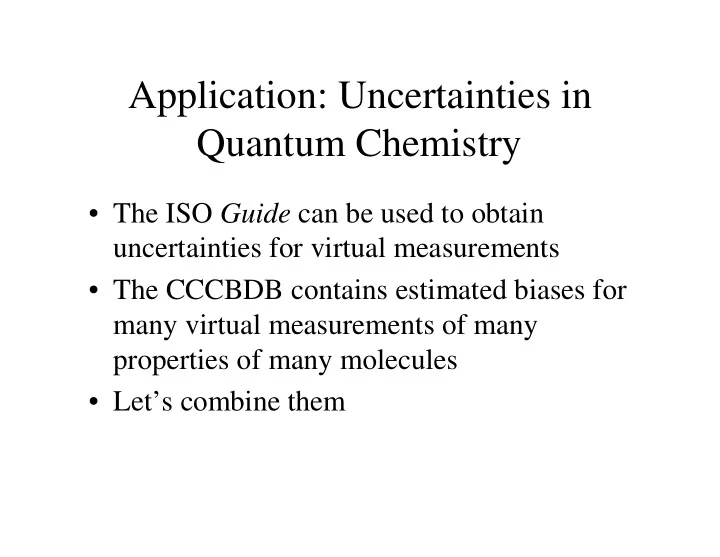

Application: Uncertainties in Quantum Chemistry • The ISO Guide can be used to obtain uncertainties for virtual measurements • The CCCBDB contains estimated biases for many virtual measurements of many properties of many molecules • Let’s combine them
Bias in Quantum Chemistry • There are two dominant contributions – Theoretical approximation (bias B t ) – Basis set truncation (bias B b ) • Some popular theories and basis sets can be ordered – Let N t be the ordinal number for a theory – Let N b be the ordinal number for a basis set • Correlation – B t , B b independent for large enough N t , N b – B t , B b not independent for typical N t , N b • So for typical methods, consider only aggregate bias B (t,b)
Uncertainty: Additive Bias • Correcting the virtual measurement – Model output plus estimated correction for bias: = + y x c 0 ( t, b ) ( t, b ) – Uncertainty: u ( y 0 ) = u ( c (t,b) ) since u ( x (t,b) ) ≈ 0 • Estimated values of c (t,b) and u ( c (t,b) ) are mean and standard deviation of corrections for similar molecules in the CCCBDB • Relies upon good classification of “similar” molecules
Example: Atomization Energy 25 • Atomization: shredding a molecule into its 20 constituent atoms, e.g., Number of molecules H 2 O → 2H + O 15 • Consider all sulfur- containing molecules in 10 the CCCBDB (plot at right) 5 • Skewed distribution suggests poor classification 0 -50 0 50 100 150 200 250 Estimated Correction (kJ mol -1 ) m Mean Standard deviation Skewness 65 50.5 64.2 1.7
Example: Classification 25 with S-O bonds • Two classes here: with without S-O bonds 20 or without S-O bonds Number of molecules 15 • New distributions better characterized by 10 mean and standard deviation 5 0 -50 0 50 100 150 200 250 Estimated Correction (kJ mol -1 ) m Set Mean Standard deviation Skewness All 65 50.5 64.2 1.7 With S-O 13 165.2 52.0 0.5 21.8 19.0 No S-O 52 0.6
Example: Atomization of ethyl thioformate (C 3 H 6 OS) • Contains no S-O bonds H 2 H • Choose a model C S C H 3 C O – Theory: mPW1PW91 – Basis set: 6-31G(d) = -1 x • Virtual measurement: 4093.8 kJ mol (4116 ± 38) kJ mol -1 = - 1 c 21.8 kJ mol • Physical measurement: = + = - 1 y x c 4115.6 kJ mol (4129 ± 5) kJ mol -1 = - 1 u c 2 ( ) 38.0 kJ mol
Uncertainty: Fractional Bias • Correcting the virtual measurement – Multiplicative correction for bias: = × y x c 0 ( t, b ) ( t, b ) – Uncertainty: u ( y 0 ) = x 0 × u ( c (t,b) ) since u ( x (t,b) ) ≈ 0 • Recall weights a i : = = c � a c � a c z x , where / i i i i i i ( t, b ) = − u c a c c 2 a � � ( ) [ ] i i i ( t, b ) ( t, b )
Example: Vibrational Frequencies • Multiplicative scaling is established practice – most cited paper is by Scott and Radom, 1996 (1700 citations) • But no uncertainties available (yet) • Least-squares corres- ponds to weighting: a = x 2 i i
Preliminary Results Model S&R Ours Uncert. AM1 0.9532 0.9530 0.1176 PM3 0.9761 0.9730 0.1553 HF/3-21G 0.9085 0.9044 0.0812 HF/6-31G(d) 0.8953 0.8982 0.0476 HF/6-31G(d,p) 0.8992 0.9025 0.0492 MP2-fu/6-31G(d) 0.9427 0.9414 0.0518 MP2-fc/6-31G(d) 0.9434 0.9423 0.0532 MP2-fc/6-31G(d,p) 0.9370 0.9365 0.0643 QCISD-fc/6-31G(d) 0.9537 0.9512 0.0433 B-LYP/6-31G(d) 0.9945 0.9910 0.0553 B3-LYP/6-31G(d) 0.9614 0.9591 0.0556 B3-PW91/6-31G(d) 0.9573 0.9561 0.0438
Distribution for HF/6-31G(d) 10000 1000 Frequency 100 10 1 0.0 0.5 1.0 1.5 2.0 2.5 3.0 3.5 Scaling factor
Vibrational Frequencies: Conclusions • Uncertainties in scaling factors are much larger than implicit – Only two significant figures, not four • Uncertainty in scaling factor can be trivially propagated to the frequencies – No uncertainties were available previously
Summary • Extension of ISO Guide to virtual measurements • Application to quantum chemistry enabled by CCCBDB: http://srdata.nist.gov/cccbdb • Initial application reveals uncertainties larger than expected – Work is in early stage and is ongoing
Recommend
More recommend